14/09/2020
Wind instrument
A wind instrument is a musical instrument that contains some type of resonator (usually a tube) in which a column of air is set into vibration by the player blowing into (or over) a mouthpiece set at or near the end of the resonator. The pitch of the vibration is determined by the length of the tube and by manual modifications of the effective length of the vibrating column of air. In the case of some wind instruments, sound is produced by blowing through a reed; others require buzzing into a metal mouthpiece, while yet others require the player to blow into a hole at an edge, which splits the air column and creates the sound.
Wind instruments are typically grouped into two families:
- Brass instruments (horns, trumpets, trombones, euphoniums, and tubas)
- Woodwind instruments (recorders, flutes, oboes, clarinets, saxophones, and bassoons)
Although brass instruments were originally made of brass and woodwind instruments have traditionally been made of wood, the names refer to the method by which a player produces sound rather than the material of the instrument, which may vary. For example, the saxophone is typically made of brass, but is classified as a woodwind instrument because it produces sound with a vibrating reed. On the other hand, the didgeridoo, the wooden cornet (not to be confused with the cornet, which is made of brass), and the serpent are all made of wood (or plastic tubing, in the case of modern serpents), and the olifant made from ivory, but all of them belong to the family of brass instruments because the vibrating is done by the player’s lips.
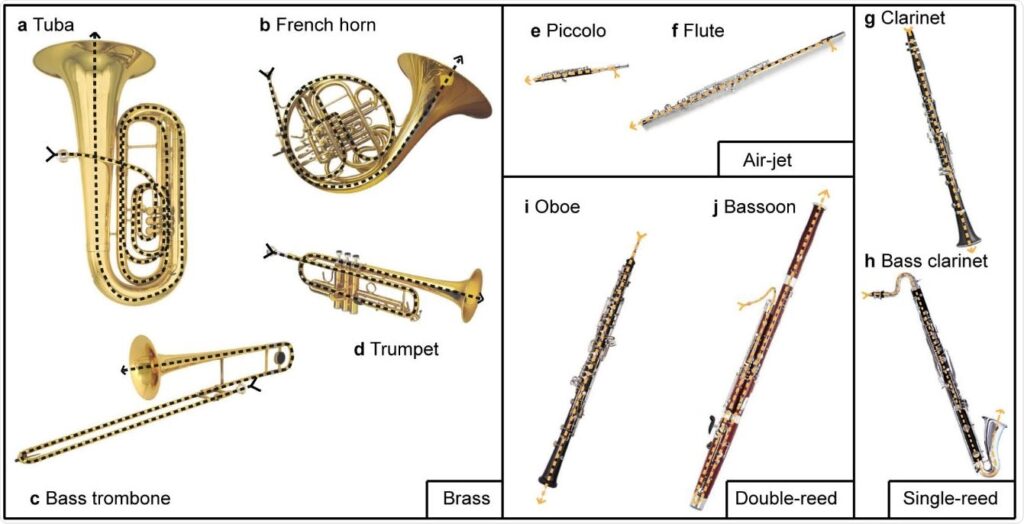
- In brass instruments, the player’s lips themselves vibrate, causing the air within the instrument to vibrate.
- In woodwind instruments, the player either:
- blows across the edge of an open hole (as in a flute).
- In the Hornbostel-Sachs scheme of musical instrument classification, wind instruments are also classed as aerophones.
Assignment
- How many categories of wind instruments are available? A. 2 B. 3 C. 4 D. 5
- The bassoon is a ____________ musical instrument. A. horn B. woodwind C. brass D. string
- The wind instruments could also be referred to as _____________ A. chordophones B. membranophones C. aerophones D. idiophones
- The trumpet and tuba are categorized under ___________ instruments.
A. brass B. percussion C. woodwind D. strings
10/09/2020 Correction to the last assignment
- Quintet
- Sextet
- Quartet
- Trio
- Solo
07/09/2020
Good morning students, I hope you are all having a good time at home.
our tropic for this week is;
SINGING/ PERFORMING ENSEMBLES IN MUSIC
In Western classical music, smaller ensembles are called chamber music ensembles. The terms solo, duet, trio, quartet, quintet, sextet, septet, octet, nonet and decet describe one performer, and groups of two up to seven musicians.
Solo
In music, a solo (from the Italian: solo, meaning alone) is a piece or a section of a piece played or sung featuring a single performer, who may be performing completely alone or supported by an accompanying instrument such as a piano or organ, a continuo group (in Baroque music), or the rest of a choir, orchestra, band, or other ensemble. Performing a solo is “to solo”, and the performer is known as a soloist.
The plural is soli or the anglicised form solos. In some context these are interchangeable, but soli tends to be restricted to classical music, and mostly either the solo performers or the solo passages in a single piece.
Duet
A duet is a musical composition for two performers in which the performers have equal importance to the piece, often a composition involving two singers or two pianists. It differs from a harmony, as the performers take turns performing a solo section rather than performing simultaneously.
Trio
A trio is a group of three people who are playing musical instruments or singing together. The word “trio” may also refer to the piece of music that they are playing.
Three people who are singing together are a “vocal trio”.
Classical composers writing chamber music very often wrote trios. Usually the trio is called after the main instrument in the group. A piano trio is normally a piece for piano, violin and cello. A string trio is a piece for three string instruments, usually violin, viola and cello.
Quartet
Quartet, a musical composition for four instruments or voices; also, the group of four performers. Although any music in four parts can be performed by four individuals, the term has come to be used primarily in referring to the string quartet (two violins, viola, and cello), which has been one of the predominant genres of chamber music since about 1750. The term may also denote such derivatives as the piano quartet, flute quartet, oboe quartet, and so on—usually a string trio combined with a fourth instrument.
Quintet
A quintet is a group containing five members. It is commonly associated with musical groups, such as a string quintet, or a group of five singers, but can be applied to any situation where five similar or related objects are considered a single unit.
Sextet
Musical compositions with six parts are sextets. Many musical compositions are named for the number of musicians for which they are written. If a piece is written for six performers, it may be called a “sextet”.
Septet
A septet is a formation containing exactly seven members. It is commonly associated with musical groups but can be applied to any situation where seven similar or related objects are considered a single unit, such as a seven-line stanza of poetry. In jazz, a septet is any group of seven players, usually containing a drum set, string bass or electric bass, and groups of one or two of the following instruments, guitar, piano, trumpet, saxophone, clarinet, or trombone.
Assignment
Highlight the names of each of the following numbers in ensemble
- five performers
- six performers
- four performers
- three performers
- a single performer
Correction to the last assignment.
- D
- B
- D
31/08/2020
Hello wonderful students, I hope you are safe and sound. I would like to apologize for the inability to have class with you last week, it was due to technical reason. I promise that such would not repeat itself. The topic for this week is;
INVERSION OF TRIADS
A triad is inverted when a note other than the root is acting as the bass note. When the root is in the bass the triad is said to be in root position. When the third is in the bass the triad is in first inversion and when the fifth is in the bass the triad is in second inversion.
A system of numbers is used along with roman numerals to indicate when triads are inverted. When a triad is in first inversion the number “6” is placed after the roman numeral and when a triad is in second inversion the numbers “6” and “4” are placed after the roman numeral. (No number after the roman numeral means that the triad is in root position.)
Inversions and chord positions: symbols
When the bass note is not the same as the root note, the chord is said to be inverted.
The number of inversions that a chord can have is one less than the number of chord members it contains. Triads, for example, (having three chord members) can have three positions, two of which are inversions:
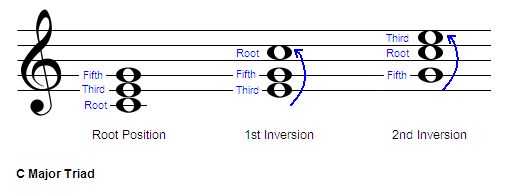
- Root position: The root note is in the bass, and above that are the third and the fifth. In the first scale degree this is marked ‘I’ or I 5/3
- First inversion: The third is in the bass, and above it are the fifth and the root. This creates an interval of a sixth and a third above the bass note, and so is marked in figured Roman notation as ‘6/3’. This is commonly abbreviated to ‘6’ (or ‘Ib’) since the sixth is the characteristic interval of the inversion, and so always implies ‘6/3’.
- Second inversion: The fifth is in the bass, and above it are the root and the third. This creates an interval of a sixth and a fourth above the bass note, and so is marked as ‘6/4’ or ‘Ic’. Second inversion is the most unstable chord position.
- Inverted triads :the first three chords played are C major root position, first inversion, second inversion; then C minor root position, first inversion, second inversion.


Assignment
1. How many notes are required to make a triad?
A.6 B.5 C.4 D.3
2. One of these represents the first inversion of a triad.
A. 5/3 B. 6/3 C. 6/4 D. 6/5
3. How many inversions are possible within a triad?
A. 5 B.4 C.3 D.2
26/08/2020
Correction to the last assignment
Section 1
- 4th
- 6th
- 3rd
- 3rd
- 3rd
- 5th
- 4th
Section 2
Aug 5th
Per 5th
Aug. 2nd
Aug. 4th
17/08/2020 INTERVAL
In music theory, an interval is the difference in pitch between two sounds. An interval may be described as horizontal, linear, or melodic if it refers to successively sounding tones, such as two adjacent pitches in a melody, and vertical or harmonic if it pertains to simultaneously sounding tones, such as in a chord.
Intervals are the distances between any two notes. Each interval will have a number – 1, 2, 3, 4, 5, 6, 7, 8. These numbers are the distance between two notes, based upon counting the lines and spaces on the staff.

For example, if we count lines and spaces, starting from C and ending on G, we count: C,D,E,F,G = 1,2,3,4,5, Therefore, the interval from C to G is a fifth (5th).
We can also keep counting past 8, through 9, 10, 11, 12, and 13, but usually not more than 13.
List of interval types:
- Unison – 1
- Second – 2nd
- Third – 3rd
- Fourth – 4th
- Fifth – 5th
- Sixth – 6th
- Seventh – 7th
- Octave – 8ve
- Ninth – 9th
- Tenth – 10th
- Eleventh – 11th
- Twelfth – 12th
- Thirteenth – 13th
Interval quality:
Intervals also have another identifier in addition to number called the interval quality. Intervals can be called
Perfect intervals
There are three intervals that are what we call perfect intervals:
- a perfect 4th
- a perfect 5th
- a perfect 8ve (or octave)
To be a perfect interval the upper note has to be in the major scale of the lower note.
If the interval is a 4th, 5th or 8ve and isn’t in the major scale, then it’s not a perfect interval.
For example C to F# is a 4th but is not a perfect 4th as F# is not in C major scale.

Major intervals
There are four intervals that are called major intervals:
- a major 2nd
- a major 3rd
- a major 6th
- a major 7th
So if the upper note of an interval is in the major scale of the lower note (and it’s not a 4th, 5th or 8ve) then it will be a major interval.
When answering questions about intervals you should always work out the number of the interval first by using the lower note as number one and counting how many letter notes there are to the higher note.
Then, if the upper note is in the major scale of the lower note you know that it is going to be either a major interval or a perfect interval.
If it’s a 4th, 5th or an 8ve, then it will be a perfect interval, if it’s another interval then it will be a major interval.
Here’s C major scale with the major intervals marked:
This is the case for every major scale, not just C major.
If the lower note is the tonic and the upper note is in the major scale, it will always either be a major or perfect interval.

Minor intervals
If we take any of the major intervals we looked at above and make them smaller by one semitone (half step) then they now are minor intervals.
For example, if we took C to E which is a major 3rd and flattened the E to make it an Eb, it now becomes a minor 3rd.
Because there are only four major intervals there are also only four minor intervals possible which are:
- minor 2nds
- minor 3rds
- minor 6ths
- minor 7ths
Here is F major scale but with the 2nd, 3rd, 6th and 7th notes flattened to become minor intervals.

Augmented Intervals
An interval becomes augmented when we extend a major or perfect interval by one semitone (half step) without changing the letter name.
So if we took a major second like F to G and made the G a G#, then we’ve made the interval wider by one semitone and so it’s now an augmented 2nd.
It’s the same with perfect intervals, for example, the interval F to C is a perfect 5th but if we make it F to C# (widening the interval) then it’s now an augmented 5th.

Diminished intervals
If we flatten any of the three perfect intervals – 4ths, 5ths or 8ves by a semitone, they don’t become minor, they become diminished intervals.
Let’s take the two notes A and D which is a perfect 4th. If we were to flatten the D to make it a Db it would now become a diminished 4th.

– Major (M),
-minor (m),
-Perfect (P),
-Augmented (A), or
-diminished (d)
Assignment
Highlight the interval between each of the following notes:
| E.g From C – E | 3rd |
| 1. F – B | |
| 2. A – F | |
| 3. B – D | |
| 4. G – B | |
| 5. A – C | |
| 6. B – F | |
| 7. E – A |
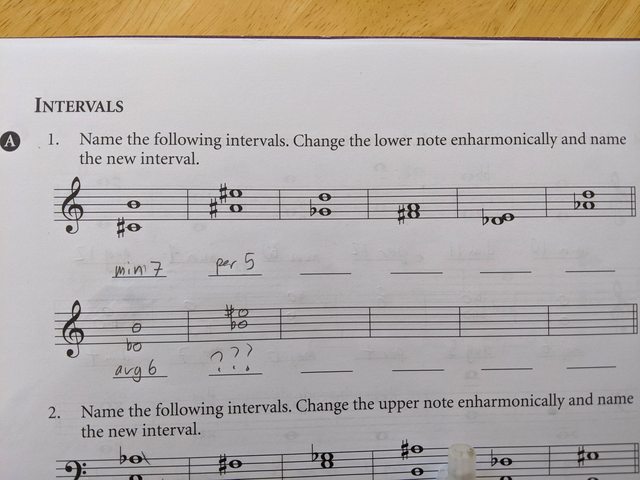
10/08/2020
AFRICAN MUSIC AND MUSICAL INSTRUMENTS
Music is important in the life of African people. In America, we tend to be spectators or listeners. Nearly everyone in Africa sings and plays one or two instruments. Africans make music in the home, at the market place, and at social gatherings. Also, music plays an important part in political, religious, and ceremonial life. Music has roles in healing, at trials, announcing the presence of very important people like chiefs and kings, weddings, funerals, and visits of important people. The person who plays the instruments often is the maker. Materials for the instruments are usually from nature, like wood, gourds, turtle shells, animal horns or skin. Other materials might be recycled from man-made objects, like scrap metal from old cars or oil drums. Blacksmiths or artists trained in instrument making create them for important people and groups. They decorate their instruments so that they not only sound good but are so beautiful they are considered works of art.
Classification of African musical Instruments
There are four classes of African musical instruments which include:
- Membranophones
- Idiophones
- Chordophones
- Aerophones
Musical instruments in which the sound-producing medium is a vibrating membrane fall into four main groups: kettledrums and bowl-shaped drums; tubular drums whether cylindrical, barrel, conical, double conical, hourglass, goblet, or shallow and rattle drums, the membranes of which are set in motion by enclosed pellets or by knotted ends of a thong or cord; friction drums, with membranes caused to vibrate by friction; and mirlitons, whose membranes are set in motion by the sound of an instrument or the human voice.
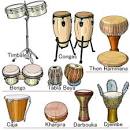
Idiophones
Idiophone, class of musical instruments in which a resonant solid material such as wood, metal, or stone vibrates to produce the initial sound. The eight basic types are concussion, friction, percussion, plucked, scraped, shaken, stamped, and stamping. In many cases, as in the gong, the vibrating material itself forms the instrument’s body. Other examples include xylophones and rattles.
The word means “self-sounding” and explains it all: It’s the instrument’s whole body that resonates without the need of attached membranes (animal skin).
Any object that sounds when being struck, shaken, scraped or stamped is a self-sounding instrument. So basically even your clapping hands and stamping feet.

Chordophones
Chordophone, any of a class of musical instruments in which a stretched, vibrating string produces the initial sound. The five basic types are bows, harps, lutes, lyres, and zithers. The name chordophone replaces the term stringed instrument when a precise, acoustically based designation is required.
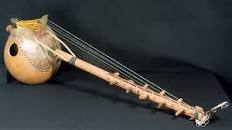
kudu
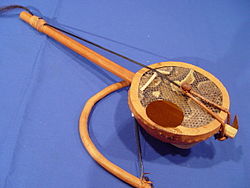
goge/goje
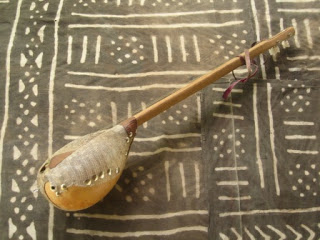
garaya
Aerophones
An aerophone is a musical instrument that produces sound primarily by causing a body of air to vibrate, without the use of strings or membranes, and without the vibration of the instrument itself adding considerably to the sound. Any of a class of musical instruments in which a vibrating mass of air produces the initial sound. The basic types include woodwind, brass, and free-reed instruments, as well as instruments that fall into none of these groups, such as the bull-roarer and the siren. Bagpipes and organs are hybrids with different kinds of pipes. The word aerophone replaces the term wind instrument when an acoustically based classification is desired.
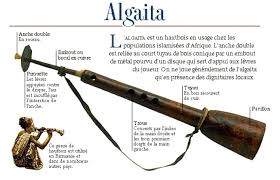
Ekutu (animal horn)
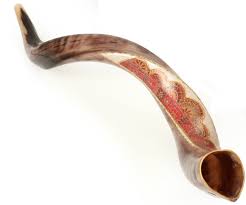
Assignment
- Highlight three African musical instruments under each of the following classes: a. membranophone b. idiophone c. aerophone d. chordophone
26/08/2020
Ten different dances in Nigeria
- Bata Dance
- Koroso Dance
- Swange Dance
- Ukwata Dance
- Atilogwu Dance
- Gese Dance
- Ijo oge Dance
- Sharo Dance
- Owigiri Dance
- Elese Dance
- Kosoko Dance
- Obitun Dance
- Kabulu Dance
- Grani Dance
- Wapakbo Dance
CORRECTION TO THE LAST ASSIGNMENT
03/08/2020
Hello students. I hope you are all enjoying yourselves at home.
our topic for this week is:
DANCE IN NIGERIA
Nigeria is made up of over 350 tribes which all have their peculiar cultures and traditions of which dance is among.
The cultural or traditional dances of Nigerian tribes are used for different purposes which include: unifying the members of a tribe; telling folktales or the history and traditions of a community; showcasing the wealth and strength of a tribe; celebrating; performing religious duties; entertaining and so on.
Below is a compilation of probably the best and most entertaining traditional dances in Nigeria.
Traditional dances in Nigeria are many and reflect every aspect of life: from simple entertainment to worshiping the gods, wars and marriage. Many of them still exist and are performed at different events and festivals. Dances is an integral part of every culture. It is almost impossible to mention all of them as the country is the motherland for many tribes, but the most popular types of dance in Nigeria are described here.
-Ukwata Dance: This dance is traditional for Abbi people who usually perform it at the Ukwata Festival. It has the religious roots and looks like worshipping the gods.
-Atilogwu Dance: It looks more like acrobatic performance, than a dance and resembles modern cheerleader shows. Mostly young people take part in Atilogwu at various kinds of events and festivals just for fun. Ikpirikpi-ogu This dance is characteristic for Abam people in Abia State and considered to be a war dance. Its unique feature: it was performed only by men who came back from war to celebrate their courage and prowess.
-Bata Dance: It is a traditional dance of Yoruba people and is dedicated to the god of thunder – Sango. Bata drum is done to the music of bata drum.
-Gese Dance: This one is Yoruba cultural dance and has the name which is referred to the type of drums. It has religious roots and it is kind of worship to Yoruba gods.
Assignment
- Make a research and list ten (10) dance styles in Nigeria.
Correction to the last assignment
- B
- C
- A
- B
- C
27/07/2020
Good morning students. I hope you are doing well at home with your parents. Thank God for giving us hope. You are all blessed in Jesus name. Please read, study and attempt the note and questions given below.
TECHNICAL NAMES OF MAJOR SCALE
What are the technical names? The ‘technical names’ in music are a set of 7 terms that give a label to every note of the scale. Every note is assigned a different technical name that reflects its position in the scale. The 7 technical names are listed here:
Tonic: 1st note of the scale (I)
Supertonic: 2nd note of the scale (II)
Mediant: 3rd note of the scale (III)
Subdominant: 4th note of the scale (IV)
Dominant: 5th note of the scale (V)
Submediant: 6th note of the scale (VI)
Leading note: 7th note of the scale (VII)

These technical terms remain the same for every scale and key, be it major or minor. They are normally used to help with analysis, determining the various roles of the individual degrees of the scale from C to G.
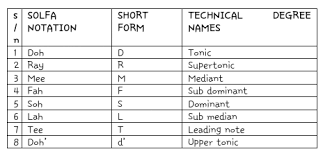
What do the Technical Names in Music Mean?
It’s quite fascinating (and useful!) to look at where the technical names actually come from. Each one of these terms reflects the note’s position in the scale and so it also reveals the note’s relationship to the tonic (or we can say, it describes the note’s distance from the tonic).
So the tonic, which we’ve met several times already, is the technical name for the 1st note of the scale. A little bit of research reveals that the word ‘tonic’ comes from the word ‘tone’, which simply means ‘musical sound’. So think of the tonic simply as ‘home sound’.
The second degree is called Supertonic. The word ‘super’ originally meant ‘that which comes after’. So obviously the supertonic is the note that comes after the tonic.
Sitting halfway in between tonic and dominant is the Mediant. The term comes from the Latin word meaning middle.
While the dominant is a fifth up from tonic, the fourth note is a fifth down from tonic and so it is known as the Subdominant. The prefix ‘sub’ referring to the fact that it is down from the tonic.
The Dominant is the 5th note of the scale and it’s called so because it’s the most important note after the tonic. It’s very important because the it’s the chord that helps establish the tonic as tonic. One note or chord by itself could belong to various keys but that same chord preceded by its own dominant, establishes it strongly as tonic.
The submediant is the sixth degree (6th) of the diatonic scale, the lower mediant—halfway between the tonic and the subdominant (“lower dominant”).
At the same time, the seventh note is called the Leading Tone, as it leads us back to the tonic.
Assignment
- The technical name of the third degree of major scale is ___________ . A. supertonic B. mediant C. submediant D. leading note
- The seventh degree of the scale is referred to as _______________ . A. tonic B. dominant C. subdominant D. leading note
- The technical names are used to reflect the _____________ of notes. A. progression B. position C. condition D. correction
- One of the following comes after the dominant note. A. Subdominant B. Submediant C. Supertonic D. Tonic
- The tonic could also be referred to as ____________ . A. street note B. road note C. home note D. big note
21/07/2020
Correction to the last assignment
- Four types of recorder includes: a. soprano recorder b. treble recorder c. tenor recorder d. bass recorder
- The labelled parts of the recorder are: a. beck b. labium c. tone hole d. wind way e. head joint f. middle joint g. foot joint
- The recorder belongs to the wood wind family.
- The materials for recorder construction are: a. ivory b. metal c. hard wood d. plastic e. synthetic ceramics
20/07/2020 RECORDER PLAYING
The recorder is a very old European instrument that dates all the way back to the 14th century, possibly originating in Italy. It’s an appealing and appropriate modern-day instrument for young children who are just beginning to unfold their musical abilities and potential. The recorder is also a simple and versatile instrument to learn that allows the player to practice attention and focus, to help train and develop the ear, and to further aid in reading and composing musical notation.
The sound of the recorder is often described as clear and sweet, and has historically been associated with birds and shepherds. It is notable for its quick response and its corresponding ability to produce a wide variety of articulations. This ability, coupled with its open finger holes, allow it to produce a wide variety of tone colors and special effects. Acoustically, its tone is relatively pure and, when the edge is positioned in the center of the airjet, odd harmonics predominate in its sound (when the edge is decidedly off-center, an even distribution of harmonics occurs).
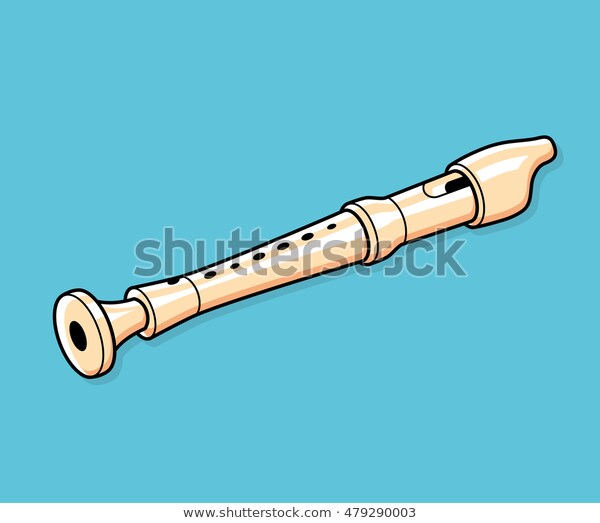
CONSTRUCTION OF RECORDERS
Recorders have historically been constructed from hardwoods and ivory, sometimes with metal keys. Since the modern revival of the recorder, plastics have been used in the mass manufacture of recorders, as well as by a few individual makers.
Today, a wide variety of hardwoods are used to make recorder bodies. Relatively fewer varieties of wood are used to make recorder blocks, which are often made of red cedar, chosen because of its rot resistance, ability to absorb water, and low expansion when wet. A recent innovation is the use of synthetic ceramics in the manufacture of recorder blocks.
Basic sound production
The recorder produces sound in the manner of a whistle or an organ flute pipe. In normal play, the player blows into the windway (B), a narrow channel in the head joint, which directs a stream of air across a gap called the window, at a sharp edge called the labium (C). The air stream alternately travels above and below the labium, exciting standing waves in the bore of the recorder, and producing sound waves that emanate away from the window. Feedback from the resonance of the tube regulates the pitch of the sound.
labelled parts of recorder

Assignment
1. Highlight four types of recorder.
2. mention four parts of recorders.
3. What group of instruments does recorders belong to?
4. State three materials that can be used to construct recorders.
14/07/2020 Correction to the last assignment
- C
- D
- D
- C
- B
13/07/2020 Key signature
Key signature, in musical notation, the arrangement of sharp or flat signs on particular lines and spaces of a musical staff to indicate that the corresponding notes, in every octave, are to be consistently raised (by sharps) or lowered (by flats) from their natural pitches. (The keys of C major and A minor, having no sharps or flats, have no key signature.) The key signature is placed after the clef indication (treble or bass, for example) at the beginning of a staff or after a double bar line—the separation necessary for a change of signature—within a staff. In Western tonality, specific groupings represent the major and minor keys.

Accidental
An accidental is an exception to the key signature, applying only to the measure and octave in which it appears. There are three types of accidentals which includes: Sharp, flat and natural.
Each major and minor key has an associated key signature that sharpens or flattens the notes which are used in its scale.
Relationship between key signature and key
The key signature defines the diatonic scale that a piece of music uses without the need for accidentals. Most scales require that some notes be consistently sharped or flatted. For example, the only sharp in the G major scale is F sharp, so the key signature associated with the G major key is the one-sharp key signature.
Sharp(#) Series
| Major key | Number of sharps | Sharp notes | Minor key | Enharmonic equivalent |
|---|---|---|---|---|
| C major | 0 | – | A minor | None |
| G major | 1 | F♯ | E minor | None |
| D major | 2 | F♯, C♯ | B minor | None |
| A major | 3 | F♯, C♯, G♯ | F♯ minor | None |
| E major | 4 | F♯, C♯, G♯, D♯ | C♯ minor | None |
| B major | 5 | F♯, C♯, G♯, D♯, A♯ | G♯ minor | C♭ major/A♭ minor |
| F♯ major | 6 | F♯, C♯, G♯, D♯, A♯, E♯ | D♯ minor | G♭ major/E♭ minor |
| C♯ major | 7 | F♯, C♯, G♯, D♯, A♯, E♯, B♯ |
| Major key | Number of flats | Flat notes | Minor key | Enharmonic equivalent |
|---|---|---|---|---|
| C major | 0 | – | A minor | None |
| F major | 1 | B♭ | D minor | None |
| B♭ major | 2 | B♭, E♭ | G minor | None |
| E♭ major | 3 | B♭, E♭, A♭ | C minor | None |
| A♭ major | 4 | B♭, E♭, A♭, D♭ | F minor | None |
| D♭ major | 5 | B♭, E♭, A♭, D♭, G♭ | B♭ minor | C♯ major/A♯ minor |
| G♭ major | 6 | B♭, E♭, A♭, D♭, G♭, C♭ | E♭ minor | F♯ major/D♯ minor |
| C♭ major | 7 | B♭, E♭, A♭, D♭, G♭, C♭, F♭ | A♭ minor | B major/G♯ minor |
Assignment
- One of these has two (2) sharp key signatures. A. F major B. G major C. D major D. A major
- There are ________ main types of key signature. A.5 B. 4 C. 3 D. 2
- One of these is the enharmonic of C major. A. D minor B. C minor C. B minor D. A. minor
- Which of the following has one flat key signature? A. D major B. E major C. F major D. G major
- How many notes has an octave? A. 16 B. 8 C. 4 D. 2
07/07/2020 CORRECTION TO THE LAST ASSIGNMENT
1. A minor
2. E minor
3. B minor
4. D minor
5. C sharp or D flat minor
06/07/2020 NATURAL MINOR SCALES
In music, relative keys are the major and minor scales that have the same key signatures, meaning that they share all the same notes but are arranged in a different order of whole steps and half steps. A pair of major and minor scales sharing the same key signature are said to be in a relative relationship. The relative minor of a particular major key, or the relative major of a minor key, is the key which has the same key signature but a different tonic;
The minor key starts three semitones below its relative major; for example, A minor is three semitones below its relative, C major.
For example, G major and E minor both have a single sharp in their key signature at F♯; therefore, E minor is the relative minor of G major, and conversely G major is the relative major of E minor, The tonic of the relative minor is the sixth scale degree of the major scale, while the tonic of the relative major is the third degree of the minor scale.
A minor is a minor scale based on A, with the pitches A, B, C, D, E, F, and G. Its key signature has no flats and no sharps. Its relative major is C major and its parallel major is A major.
E minor is a minor scale based on E, consisting of the pitches E, F♯, G, A, B, C, and D. Its key signature has one sharp. Its relative major is G major and its parallel major is E major.
B minor is a minor scale based on B, consisting of the pitches B, C♯, D, E, F♯, G, and A. Its key signature consists of two sharps. Its relative major is D major and its parallel major is B major.
F-sharp minor is a minor scale based on F♯, consisting of the pitches F♯, G♯, A, B, C♯, D, and E. Its key signature has three sharps. Its relative major is A major and its parallel major is F-sharp major (or enharmonically G-flat major).

ASSIGNMENT
- Highlight the relative minor of the following major keys:
- C major
- G major
- D major
- F major
- E major
30/06/2020
Good afternoon students.
Correction to the last assignment
- Melodic minor scale
- Harmonic minor scale
- la
- whole, half, whole, whole, half, whole, whole
CONSTRUCTION OF MINOR SCALE
The minor scale is the scale which sounds negative – it is used by composers to depict sad, melancholic or even angry/dramatic moods.
In music theory, the term minor scale refers to three scale patterns – the natural minor scale which the harmonic minor scale, and the melodic minor scale (ascending or descending)– rather than just one as with the major scale.
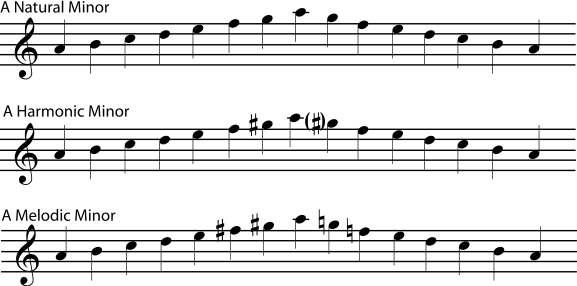
Natural minor scale
Relationship to relative major
A natural minor scale is a diatonic scale that is built by starting on the sixth degree of its relative major scale. For instance, the A natural minor scale can be built by starting on the 6th degree of the C major scale: A,B,C,D,E,F,G,A. In solfa (l,t,d,r,m,f,s,l).
Interval
The intervals between the notes of a natural minor scale follow the sequence below:
whole, half, whole, whole, half, whole, whole.
Where “whole” stands for a whole tone and “half” stands for a semitone.
The natural minor scale is maximally even.
HARMONIC MINOR SCALE
The harmonic minor scale has the same notes as the natural minor scale except that the seventh degree is raised by one semitone, creating an augmented second between the sixth and seventh degrees. A,B,C,D,E,F#,G#,A. In solfa (l,t,d,r,m,fe,se,l).
Melodic minor scale
Construction
The distinctive sound of the harmonic minor scale comes from the augmented second between its sixth and seventh scale degrees: A,B,C,D,E,F,G#,A. In solfa (l,t,d,r,m,f,se,l). While some composers have used this interval to advantage in melodic composition, others felt it to be an awkward leap, particularly in vocal music, and preferred a whole step between these scale degrees for smooth melody writing. To eliminate the augmented second, these composers either raised the sixth degree by a semitone or lowered the seventh by a semitone.
The melodic minor scale is formed by using both of these solutions. In particular, the raised sixth appears in the ascending form of the scale, while the lowered seventh appears in the descending form of the scale. Traditionally, these two forms are referred to as:
- the ascending melodic minor scale is raised on the sixth degree of the scale. This form of the scale is also the 5th mode of the acoustic scale.
- the descending melodic minor scale: This form is identical to the natural minor scale.
- ASSIGNMENT
- 1. Which of the scales is raised on the sixth and seventh degree of the minor scale?
- 2. One of the minor scales raised on the sixth degree is ______ .
- 3. The first note of the major scale is ‘d’ while the first note of the minor scale is ______ .
- 4. Highlight the intervals of the natural minor scale.
Good morning to all the wonderful students on this platform. I believe you are all doing great. well done.
please ensure that you copy the scheme of work for next term provided below in your notebook.
Weeks Topics
1. How to construct a minor scale
2. Identification of keys ( key C, G, D, and F major)
3. Great/Grand stave
4. Recorder Playing
5. Key signature
-Types of key signature
-Accidentals
6. Triads
-Tonic triads in root position
7. Technical names of musical pitches
8. Musical Terms and Signs
9. Revision of Term’s work
10. Examination Begins
11. Examination continues
12. Collation of results
13. End of results collation/Distribution of results
23/06/2020 Correction to the last assignment
- Seven (A,B,C,D,E,F,G)
- Twelve (12)
- Two semitones
- Seven notes or pitches
- Eight notes (d,r,m,f,s,l.t,d’)
Good morning students. I believe you are doing great and staying safe. I want to say well done for your consistency on this platform. May you be wiser and more knowledgeable in Jesus name. P lease be reminded again that it is expedient for you to copy this notes for future purposes.
Our topic for this week is:
MUSICAL SCALE
A scale in music can be regarded as the musical ladder of sounds ascending or descending from a starting note. It can also be termed as the arrangement of notes or sounds in a logical form. There are various scales in music, but the main and common types are:
- Major scale and
- Minor
The two types of scale are commonly used in Western classical Art music. They both consist of seven (7) notes each.
CONSTRUCTION OF MAJOR AND MINOR SCALE
The major and minor scales are easily formed with the use of the first seven letters of the English alphabets (A,B,C,D,E,F,G)as well as the solfa notes (d,r,m,f,s,l,t). The major scale could also be constructed on the pattern Tone, Tone, Semitone, Tone, Tone, Tone, Semitone (TTSTTTS). The pattern is the distance that exists between the notes of any major scale, which could be from C to upper C or F to upper F, etc.
The minor scale is constructed with pattern Tone, Semitone, Tone, Tone, Semitone, Tone, Tone (TSTTSTT). The solfa notes of minor scale is (l,t,d,r,m,f,s,).
TETRACHORD
Tetra chord is a Greek word which means four notes. When a scale is constructed by adding the first note or letter at the end of the scale (octave) , eg, C,D,E,F,G,A,B,C , it could be divided into two and each part of the division is referred to as TETRACHORD. There are two types of tetra chord which include the upper and lower tetra chords. CDEF forms the lower tetra chord of C scale, while GABC forms the upper tetra chord of the scale. The upper tetra chord could also be used to form a new scale, eg, GABC forms the lower tetra chord of GABCDEF#G i.e, G major scale.
ASSIGNMENT
- How many letters of the English alphabets are used to form musical scale?
- If the major scale has seven notes, the chromatic scale has _________ notes.
- How many semitones can be found in tone?
- A diatonic scale has ________ notes or letters.
- There are __________ notes within an octave.
18/06/2020 correction
Producer: The is the sole owner and financier of a drama production. He acts as the overall supervisor of a drama production. He is also the main employer of all hands involved in a drama production.
Director: The director controls the affairs, skills and attitude of all the casts involved in a drama production. His role is to help the actors and actresses perform their best as they portray the roles given to them in a play.
Make-up artiste: This is the individual or a group of individuals that use their skills to enhance the look of the actors and actresses in drama production. The make-up artiste helps the actors and actresses to portray their roles in a play perfectly. The make-up artiste could help change the look of a thirty years old individual to eighty or hundred years old individual and vice-versa with the use of different make-up kits/materials or substance.
Costume Designer: This is the individual in a play that chooses the appropriate costume for every character in a play production. The costume designer is an experienced and skilled garment maker who is versatile in the use of fashion designing tools (manual or electric/ electronic).
15/06/2020
The topic for this week is;
DRAMA PERSONNEL
Drama personnel are the persons namely the CAST and the CREW that play the artistic, technical as well as administrative roles in the process of producing a play for exhibition in order to make such a production a success.
CATEGORIES OF DRAMA PERSONNEL
They are the cast and crew.
CAST: Cast refers to all the people who will play different roles such as talking , singing and dancing. They are also known as the characters (actors and actresses) in a play.
CASTING
Casting is the process of selecting actors for a play. Casting is in two forms namely;
- Type casting and
- Non-type casting
- TYPE CASTING: This means selecting people whose personality or behavior fits the role to be played or acted.
- NON-TYPE CASTING: This means selecting people who have the required skills for the role but do not physically look and act like the character they are required to play. In non-type casting, make-up is used to change the appearance of the actor to fit the role to be played.
CREW: Crew in a drama production are supporting artistes such as artistic director, music director, choreographer, stage manager, casting director, costume designer, scenic or set designer and lighting designer.
Without these supporting artistes, there can be no meaningful and successful drama production.
ASSIGNMENT
Explain each of the following drama crew members:
- Producer
- Director
- Make-up artiste
- Costume designer
11/06/2020
Good morning wonderful students, thank God for yet another opportunity to study. Please, take note of the answers to last assignment given.
Short notes on;
- Trombone
- Tuba
- Piano
- TROMBONE: This is a brass wind instrument. The sound is produced by pulling a slide which serves to vary the effective length of tube forwards and backwards. The most frequently used trombones are the tenor and bass trombones.
- TUBA: This is the lowest pitched of the brass wind instruments. The standard orchestral tuba is the bass tuba pitched in “F”.
- PIANO: This is a musical instrument made with white and white keyboards.It could also be referred to as stringed instrument in which the strings are struck by felted hammers. A piano is either UPRIGHT (i.e the strings are vertical) or GRAND (i.e the strings are horizontal).
08/06/2020
Good morning students, I believe you had splendid night.
Please, I would like to enjoin all students to copy all the notes including the topics treated before as well as the assignments and the answers provided in their notebooks for future purposes.
Our topic for this week is;
NON-TRANSPOSING INSTRUMENTS
Non transposing instruments are the musical instruments that produce sound on the concert key. They do not require changing the key or pitch to the actual sound. Non-transposing instruments sound cannot be manipulated unless it is digitized. Non-transposing musical instruments include;
- Flute
- Recorder
- Oboe
- Bassoon
- Trombone
- Tuba
- Piano
-FLUTE: This is a wood-wind instrument which is held in a horizontal position. The flute and the piccolo are the only instruments which are side blown. The flute is made of metal, ebonite or hard wood. It produces sound on the concert key or as written.
-RECORDER: The recorder is a woodwind instrument which is vertically played. There are five sizes of recorder which include;
a. Soprano Recorder
b. Descant Recorder
c. Treble Recorder
d. Tenor Recorder
e. Bass Recorder
– OBOE: This is a double reed musical instrument. The oboe is a treble-sounding instrument which is vertically played.
– BASSOON: This is also a double-reed wind instrument. It is the bass instrument instrument of the of the woodwind family. Its lower note are written in the bass staff, but the higher notes are written in the tenor staff. The double Bassoon sounds an octave lower than its written notation.
ASSIGNMENT
Make a research and write short notes on;
- Trombone
- Tuba
- piano
01/06/2020 JSS2
TRANSPOSING INSTRUMENTS
These are the instruments on which the player produces a sound at a fixed interval above or below the note written. The notation of the parts for these instruments therefore is at a different PITCH from the actual sound they produce. Transposing instruments include piccolo, double bass, clarinet, horn, cor anglais, trumpet, saxophone, cornet and double bassoon.
CLASS ACTIVITY:
Explain these transposing instruments below:
- Trumpet
- Piccolo
- Saxophone
- Clarinet
- double bass
01/06/2020 CORRECTION
Short notes on;
- Contralto
- Alto
- Tenor
- Baritone
- Bass
- CONTRALTO: This is the vocal range between alto and tenor range. It is usually being produced by female vocalist in an operatic show.
- ALTO: It is the lowest female vocal range in formal choir or four parts arrangement.
- TENOR: This is the highest male vocal range in a formal choir. It is usually projected by a male with high vocal range.
- BARITONE: Baritone has the vocal range between tenor and bass. The male singer singing this range has the ability to sing between mid to very low tenor notes and high to mid bass ranges in an operatic performance.
- BASS: This is the lowest vocal range in a formal choir. It is majorly being sung by low range male vocalist in a four part choir.
Hello wonderful students.
I believe you are maintaining social distancing and staying safe.
I missed all so much.
May God Almighty see us through this pandemic period in Jesus name.
welcome to online class.
We shall be having a splendid time studying on this platform.
Our topic for this week is:
Voice Ranges
Human voice is considered to be the oldest musical instrument. It is able to produce wide range of sound and pitch. Human voice tone can be manipulated to portray emotions such as anger, happiness, joy, sorrow or sadness.
Human voice could generally be defined as the natural source of sound from which music can be made.
Human voice or vocal range simply span from the lowest to the highest note that a particular voice can produce.
The major vocal ranges are:
1. Soprano
2. Alto
3. Tenor
4. Bass
Other voice ranges prominent in Operatic show include:
1. Sopranino
2. Contralto
3. Counter tenors
4. Baritone and
5. Contra bass
Assignment
1. Define the following vocal ranges:
a. Contralto
b. Sopranino
c. baritone
d. Tenor
e. Bass
No Fields Found.
Type to Filter